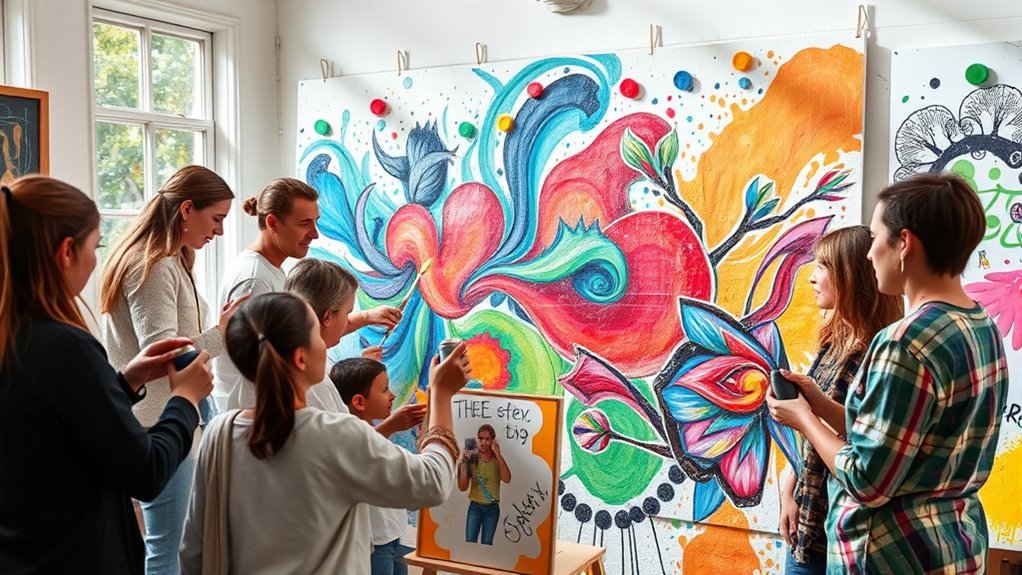Participating in collaborative art projects can considerably strengthen your teamwork skills by encouraging shared creativity, cultural understanding, and emotional connection. As you work alongside others, you learn to listen, compromise, and respect diverse perspectives. These projects foster trust and empathy, showing how collective effort results in meaningful art. If you want to discover how blending different talents and stories can transform group dynamics, there’s more to explore ahead.
Key Takeaways
- Collaborative art projects promote teamwork by encouraging equal participation and shared decision-making among participants.
- They foster communication, active listening, and understanding of diverse perspectives through collective creative processes.
- Creating shared artwork enhances trust, empathy, and mutual respect within teams or communities.
- Art projects like murals or quilts exemplify how teamwork results in meaningful, culturally rich expressions.
- Engaging in collaborative art cultivates skills such as patience, adaptability, and appreciation of differences.

Have you ever wondered how bringing people together can create something truly extraordinary? When you participate in collaborative art projects, you’re not just making art—you’re building connections, fostering understanding, and celebrating diverse perspectives. These projects serve as powerful tools for promoting teamwork, and they often incorporate elements like art therapy and cultural expression to deepen their impact. Art therapy, in particular, offers a unique way to channel emotions and experiences through creative outlets, helping individuals process feelings and share personal stories. When combined within a group setting, art therapy becomes a communal experience, where participants support each other’s healing and growth through shared expression. This collective process nurtures empathy and trust, making it easier for everyone to open up and connect on a deeper level.
Participating in collaborative art fosters connections, understanding, and healing through shared creative expression.
Cognitive processes involved in collaboration can be enhanced through engaging in creative activities, fostering both individual and group development.
Cultural expression plays an essential role in collaborative art projects because it invites participants to bring their backgrounds, traditions, and stories into the creative space. Whether it’s through traditional patterns, symbols, or storytelling styles, cultural expression enriches the project and highlights the value of diversity. As you work alongside others, you’ll learn to appreciate different viewpoints and appreciate how cultural nuances influence artistic choices. This exchange not only broadens your perspective but also teaches important skills like active listening, patience, and adaptability. By engaging with different cultural elements, you help create a tapestry of shared experiences that reflect the collective identity of the group.
In practical terms, collaborative art projects can take many forms—mural painting, group sculptures, community quilts, or digital art collaborations. No matter the medium, the key is that everyone contributes equally, bringing their unique skills and ideas to the table. This process encourages collaboration over competition, emphasizing the importance of listening and compromise. When you’re involved in these projects, you’ll find that the act of creating something together often sparks spontaneous conversations and strengthens bonds. The finished piece becomes more than just art; it’s a testament to teamwork, resilience, and the power of shared creativity.
Ultimately, collaborative art projects teach you that teamwork isn’t about uniformity but about harmonizing differences. They demonstrate how collective effort can produce something meaningful and beautiful—something that no one person could achieve alone. By blending art therapy and cultural expression, these projects foster a sense of community rooted in mutual respect and understanding. When you take part in them, you’re not just making art—you’re helping to shape a more connected, empathetic world.
Frequently Asked Questions
How Can I Start a Collaborative Art Project With Strangers?
To start a collaborative art project with strangers, you should first break the ice with fun icebreaker activities that encourage open communication. Then, facilitate idea sharing by asking everyone for their input and interests. This helps build trust and sparks creativity. Once ideas flow freely, assign roles based on strengths, and create a welcoming environment where everyone feels comfortable contributing their unique perspective.
What Are the Best Tools for Remote Collaboration in Art?
Thinking about remote collaboration tools in art is like choosing the right paintbrush for your masterpiece. You should explore digital platforms like Miro or Google Jamboard, which let you brainstorm and share ideas easily. Creative apps like Procreate or Adobe Photoshop also help you work on projects from anywhere. These tools keep everyone connected, making teamwork smooth and inspiring, even when you’re miles apart.
How Do I Resolve Conflicts During a Team Art Project?
When conflicts arise during a team art project, you should address communication barriers promptly. Encourage open dialogue where everyone can share their perspectives. Focus on understanding differing visions by mediating calmly and finding common ground. Clarify project goals and celebrate each member’s input, fostering respect. By maintaining transparency and patience, you help resolve disagreements constructively, turning challenges into opportunities for growth and stronger teamwork.
What Age Groups Benefit Most From Collaborative Art Activities?
Imagine a classroom where teenagers explore adolescent creativity by working on mural projects together, or seniors share stories through joint painting sessions. You’ll find that both age groups benefit most from collaborative art activities, as they promote teamwork and self-expression. Adolescents develop essential social skills, while seniors stay engaged and mentally sharp. So, whether young or old, creative teamwork enriches everyone’s experience, fostering connection and personal growth.
How Can Collaborative Art Projects Be Integrated Into Educational Curriculums?
To integrate collaborative art projects into educational curriculums, you should focus on promoting interdisciplinary learning and inclusive participation. Encourage students to work across subjects, combining art with science, history, or language arts. Design activities that allow everyone to contribute, regardless of skill level, fostering teamwork and creativity. By doing so, you create a dynamic environment that enhances engagement, critical thinking, and social skills, making learning enjoyable and inclusive for all students.
Conclusion
Now that you’ve seen the power of collaborative art projects, imagine what you could create together. When you combine your ideas and skills, teamwork turns into a vibrant masterpiece. Isn’t it exciting to think about the endless possibilities that arise when creativity flows freely among a group? So, why not start your own project today? Embrace the challenge, and watch as teamwork transforms your vision into something truly extraordinary.











